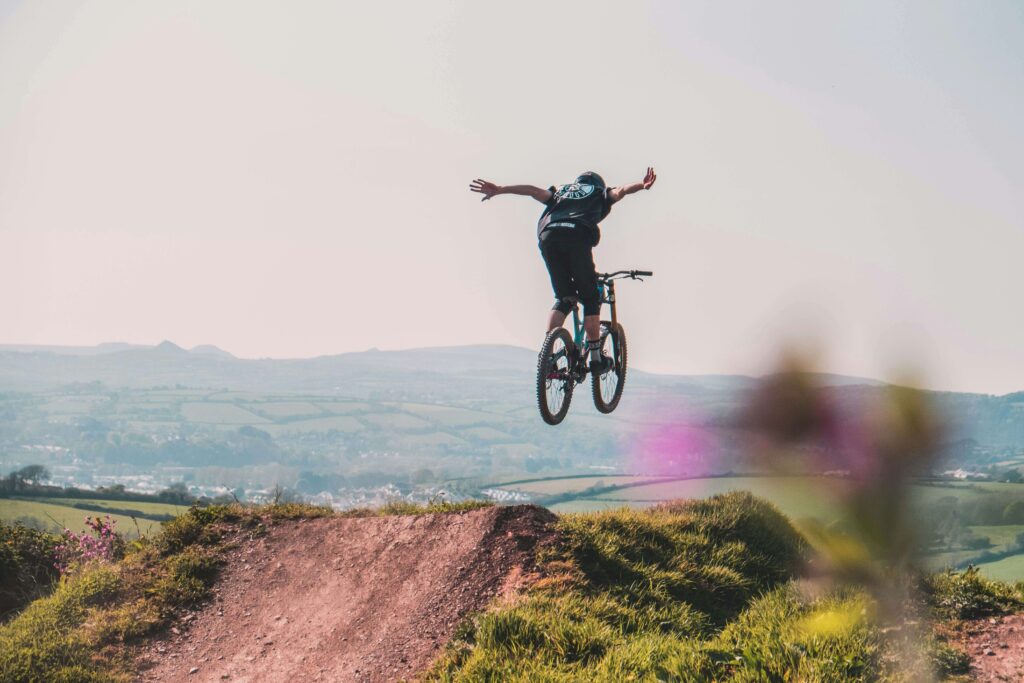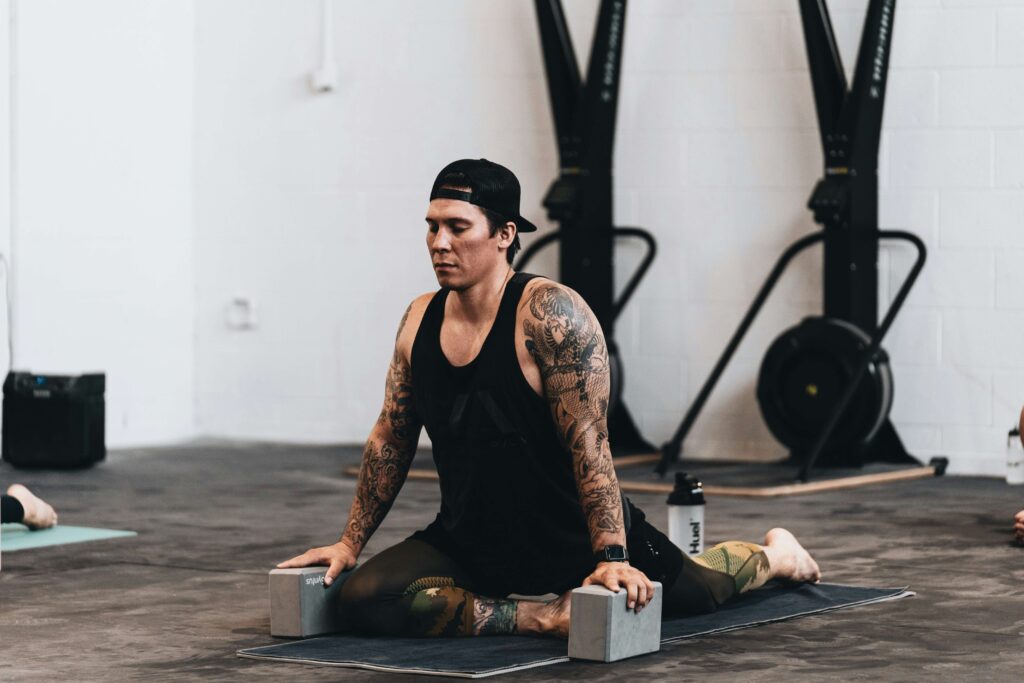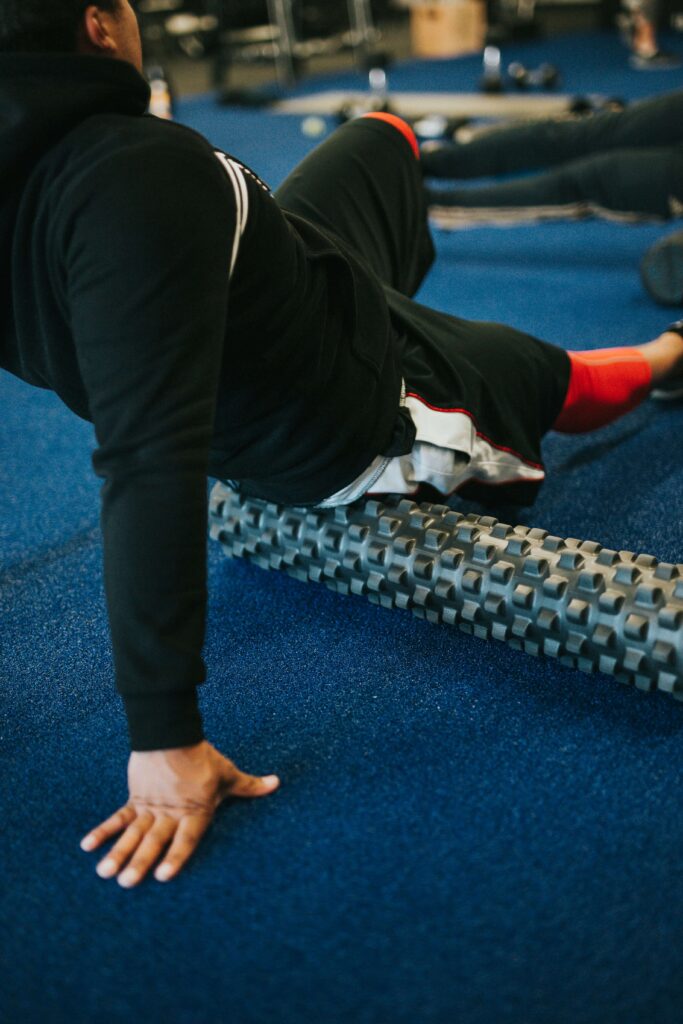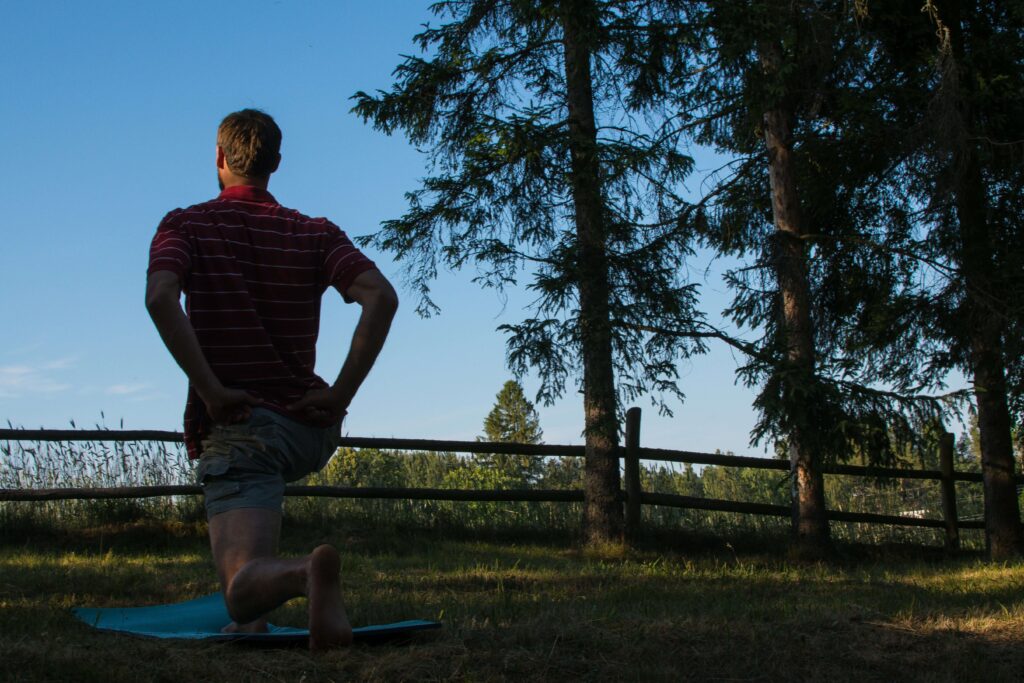Diving into mountain biking? Don’t overlook the power of Mountain Bike Stretches. These essential exercises are your key to unlocking a smoother, more enjoyable ride. In “Elevate Your MTB Game: Essential Mountain Bike Stretches for Beginners,” we’ll explore how stretching can enhance performance and prevent injuries, ensuring your mountain biking adventures are both exhilarating and safe.
If you are here only for the stretches, you can jump directly to our stretching routines:
Table of Contents
Introduction: The Intersection of Mountain Biking and Stretching
Mountain biking is a dynamic sport that challenges every part of your body, demanding not just strength and endurance but also flexibility and balance. As mountain bikers navigate varied terrains, their muscles undergo constant tension and release, making stretching an essential part of their routine. But how important is stretching, really? And when is the best time to incorporate it into your mountain biking regimen? Let’s explore these questions.
Why Should Mountain Bikers Stretch?
Stretching is vital for mountain bikers to prevent injuries, enhance flexibility, and improve overall performance on the trails. According to experts, including Dr. Samantha Smith from Yale School of Medicine, while stretching might not always be necessary before every type of exercise, it plays a crucial role in activities requiring a broad range of motion and explosive movements, typical in mountain biking.
What Types of Mountain Bike Stretches Are Most Beneficial for Mountain Bikers?
Dynamic stretches are recommended before hitting the trails, as they prepare your muscles and joints through movements similar to those you’ll perform while riding. These stretches mimic the cycling motion, improving blood flow and reducing the risk of muscle stiffness and injuries. On the other hand, static stretches, where you hold a position to lengthen the muscle, are more suitable post-ride to aid in recovery and flexibility.
Can Stretching Improve Mountain Biking Performance?
Yes, stretching can significantly improve mountain biking performance. By enhancing flexibility and range of motion, stretching allows bikers to maneuver more effectively, tackle challenging terrains with ease, and reduce the risk of muscle strains and injuries. Regular stretching, combined with a well-rounded fitness regimen, can lead to noticeable improvements in riding technique and endurance.
For a deeper understanding of the role of stretching in physical activities and its impact on performance and injury prevention, this article from the New York Times provides valuable insights from medical professionals and researchers: “How Important Is Stretching, Really?”.
Incorporating stretching into your mountain biking routine is not just about prepping for your next ride; it’s about building a foundation for long-term health, flexibility, and riding proficiency. By understanding the science behind stretching and applying it effectively, mountain bikers can elevate their riding experience and achieve new heights in their biking adventures.

Benefits of Stretching for Mountain Bikers
Stretching plays a pivotal role in enhancing the mountain biking experience. It not only prepares your body for the ride ahead but also aids in recovery post-ride. By delving into the benefits of stretching, mountain bikers can improve their flexibility, performance, and overall enjoyment of the sport.
How Does Stretching Improve Flexibility for Mountain Biking?
Improved flexibility is one of the key benefits of regular stretching for mountain bikers. Stretching the muscles regularly can increase your range of motion, which is crucial for executing the dynamic movements involved in mountain biking. This enhanced flexibility allows for easier maneuvering through challenging trails and obstacles, reducing the risk of injuries related to overextension or sudden movements.
How Does Stretching Aid in Injury Prevention for Mountain Bikers?
Stretching is crucial in injury prevention for mountain bikers. Regular stretching helps to keep the muscles flexible and pliable, which reduces the risk of strains, tears, and other muscle-related injuries. Furthermore, stretching the muscles around the joints can improve joint range of motion, decreasing the likelihood of joint-related injuries. This is especially important for a high-impact sport like mountain biking, where the risk of falls and sudden impacts is higher.
When is the Best Time to Stretch Your Muscles?
After the ride! Stretching plays a significant role in the post-ride recovery process for mountain bikers. Engaging in static stretching after a ride can help in alleviating muscle tightness and soreness by promoting blood circulation to the stretched muscles. This enhanced blood flow aids in the faster removal of metabolic waste products accumulated during intense physical activity, speeding up the recovery process and preparing the muscles for the next ride.
Understanding and incorporating the benefits of stretching into your mountain biking routine can lead to significant improvements in flexibility, performance, injury prevention, and recovery. By dedicating time to both pre-ride and post-ride stretching, mountain bikers can enjoy longer, more exhilarating rides while minimizing the risk of injury and discomfort.
Equipment and Gear to Enhance Your Stretching Sessions
Incorporating the right equipment into your stretching routine can significantly enhance flexibility, support core strength, and prevent lumbar pain. Here’s a curated selection of gear, including a yoga mat, foam roller, and resistance bands, among others, to elevate your stretching sessions:
What Essential Equipment Can Enhance My Stretching Routine?
- Yoga Mat: A high-quality yoga mat provides a comfortable, stable surface for all stretching exercises, ensuring safety and effectiveness. It’s essential for floor stretches and yoga poses, protecting your joints and improving your grip. Like the Haninj Eco-Friendly Cork Yoga Mat, personally I’m a big fan of the cork feeling.
- Foam Roller: Ideal for self-myofascial release, a foam roller (like the Maximo Fitness Foam Roller) can help relieve muscle tightness, soreness, and inflammation. It’s perfect for post-ride recovery, aiding in the release of muscle knots and improving blood circulation.
- Resistance Bands: These versatile bands can add a new dimension to your stretches by providing resistance, helping you deepen your stretches and increase your flexibility over time. They’re also great for strength training exercises, which can complement your stretching routine.



Are There Any Advanced Tools to Further Improve Flexibility and Core Strength?
- Balance Board: A balance board can challenge your core stability and proprioception, which are crucial for mountain biking. Incorporating balance exercises into your routine can enhance core strength and overall coordination.
- Stretching Strap: A stretching strap can help you achieve deeper stretches and hold poses for longer without straining. This tool is especially useful for improving flexibility in the legs, back, and shoulders.
- Yoga Blocks: Yoga blocks provide support, stability, and alignment in a variety of poses, making them essential for both beginners and advanced practitioners. They can help you safely access deeper stretches and improve your overall flexibility.
- Massage Ball: Perfect for targeting specific areas, a massage ball can help release tight muscles and trigger points. It’s an excellent tool for focusing on areas that are difficult to reach with a foam roller, like the shoulders, glutes, and feet.
Pre-Ride Warmup Routine
Starting from the top and working our way down, this pre-ride warmup routine is designed to systematically warm up your body, focusing on dynamic movements that open and prepare each major muscle group for the demands of mountain biking. Remember, the goal is to keep moving through these stretches, avoiding holding any static positions to best mimic the activity to come.
- Neck Rolls: Gently lower your ear towards your shoulder and slowly roll your head in a semi-circle, bringing your chin to your chest and then ear to the opposite shoulder. This warms up the neck muscles.
- Arm Swings: Extend your arms parallel to the ground and swing them across your chest, one over the other, then open wide again. This helps to warm up the shoulders and chest.
- Torso Twists: With feet shoulder-width apart, twist your upper body side to side, allowing your arms to swing freely. This engages your core and warms up your spine.
- Hip Circles: Place hands on hips and make large circles with your hips, first in one direction and then the other. This loosens the hip joints and warms up the lower back.
- Leg Swings (Front to Back): Stand on one leg and swing the other leg forward and back, increasing the range gradually. This stretch warms up your hamstrings and hip flexors.
- Leg Swings (Side to Side): Swing your leg side to side in front of your body, crossing over your standing leg and then swinging out to the side. This movement warms up the inner and outer thighs.
- Lunges with a Twist: Perform a forward lunge and add a twist towards the front leg, engaging the core. This warms up the lower body while stretching the torso.
- Leg Rotations for Hip Opening: Lift one knee to a 90-degree angle and rotate the leg outwards from the hip, making circular motions. This helps to open up the hips and prepare them for pedaling movements.
- Ankle Rolls: Balance on one foot and rotate your lifted foot’s ankle clockwise and then counterclockwise. Switch feet and repeat. This prepares your ankles for the ride.
- Walking Quad Stretch: As you step forward, pull one foot towards your glutes, keeping the knees close together, then release and step forward, alternating legs. This dynamically stretches the quads.
This routine covers all major muscle groups used in mountain biking, from your neck down to your ankles, ensuring a thorough warm-up. Perform each stretch for about 30 seconds to 1 minute, keeping the movements fluid and dynamic. By the end of this routine, your body should feel warmed up, flexible, and ready for the trails ahead.
Post-Ride Stretching Routine
After a rigorous mountain bike ride, it’s important to perform a series of static stretches to cool down and prevent soreness. This routine is designed to work from the top of your body down to your feet, focusing on the key muscle groups used during your ride.
- Neck Stretch: Tilt your head towards one shoulder until a stretch is felt on the opposite side of your neck. Hold for 20-30 seconds, then switch sides. This helps relieve tension in the neck muscles.
- Shoulder Stretch: Bring one arm across your body and use the other hand to press it towards your chest, stretching the shoulder. Hold for 20-30 seconds, then switch arms.
- Triceps Stretch: Reach one arm overhead, bend it at the elbow, and use your other hand to gently press on the bent elbow, stretching the triceps. Hold for 20-30 seconds before switching arms.
- Chest Opener: Clasp your hands behind your back, straighten your arms and lift your hands slightly, opening up the chest. Hold for 20-30 seconds to stretch the pectoral muscles.
- Upper Back Stretch: Extend your arms in front of you, clasp your hands together, round your back, and push your hands forward, feeling a stretch in your upper back. Hold for 20-30 seconds.
- Hip Flexor Stretch: Step into a lunge position with one foot forward, lower your back knee to the ground, and push your hips forward, stretching the hip flexor of the back leg. Hold for 20-30 seconds, then switch sides.
- Hamstring Stretch: Sit on the ground and extend one leg out, tuck the other foot into your thigh, and reach towards the toes of your extended leg. Hold for 20-30 seconds, then switch legs.
- Quad Stretch: Stand on one leg and pull your other heel towards your glutes, keeping your knees together. Hold for 20-30 seconds, then switch legs to stretch the quadriceps.
- Calf Stretch: Step one foot back, keeping it straight, and press the heel into the ground while bending the front knee. Hold for 20-30 seconds, then switch feet.
- Ankle Stretch: Sit with your legs extended in front of you, loop a towel or band around one foot, and gently pull towards you, keeping your leg straight. This stretches the calf and ankle. Hold for 20-30 seconds, then switch feet.
Take your time with each stretch, breathing deeply and focusing on relaxing into the stretch. This routine not only aids in recovery but also helps increase flexibility over time, contributing to improved performance and reduced risk of injury on future rides.
Important Side Note: Consistency is king! In a 2021 review, Dr. Behm and his team found that stretching to minimize soreness only works if you have a consistent stretching routine, separate from other workouts, that you did regularly before you started doing strenuous exercise. These stretches should last for 30 to 60 seconds for each muscle group, and be performed at least twice a week.
Core Strengthening and Overall Flexibility
For off-riding days, maintaining flexibility and core strength is crucial for mountain bikers, especially to prevent lumbar pain, a common issue due to the demanding nature of the sport. This workout routine, designed for 45 seconds of activity followed by 15 seconds of rest between exercises, is ideal for keeping your body in top condition, enhancing flexibility, and bolstering the core muscles that support your lower back.
- Strengthening: Bird Dog
- This exercise targets your core and improves balance, crucial for biking. It also engages the lower back, which is key to preventing lumbar pain.
- Flexibility: Child’s Pose
- A great stretch for the spine, shoulders, and hips, helping to release tension and maintain flexibility after intense rides.
- Strengthening: Forearm Plank
- Planks are essential for building core strength, providing stability to your lower back, and reducing the risk of lumbar pain.
- Flexibility: Standing Forward Bend
- This stretch targets your hamstrings and back, improving flexibility in areas that are crucial for cyclists.
- Strengthening: Side Plank
- Side planks not only strengthen the obliques but also offer lateral support to your spine, further aiding in lumbar pain prevention.
- Flexibility: Seated Spinal Twist
- This twist helps maintain spinal mobility and can alleviate tightness in the back, a common issue for cyclists.
- Strengthening: Superman
- Targeting the lower back and glutes, this exercise strengthens the posterior chain, essential for a strong cycling posture.
- Flexibility: Butterfly Stretch
- Focusing on the inner thighs and hips, this stretch is key for cyclists who need to maintain lower body flexibility for optimal pedaling efficiency.
- Strengthening: Glute Bridges
- Strengthening the glutes supports the lower back, reducing the strain that can lead to lumbar pain.
- Flexibility: Calf Stretch
- Keeping calves flexible is important for cyclists to prevent muscle tightness and maintain a full range of motion in the lower legs.
Incorporating this routine on days you’re not riding can significantly contribute to your overall riding performance by keeping your core strong and your body flexible. Consistency is key, so aim to complete this routine 2-3 times a week to reap the benefits and keep lumbar pain at bay.

Concluding Thoughts: Making Stretching a Pillar of Your MTB Lifestyle
Incorporating stretching into your mountain biking routine isn’t just about enhancing performance or flexibility; it’s about investing in your longevity and enjoyment in the sport. As you’ve navigated through the importance of pre-ride and post-ride stretches, core strengthening exercises, and the role of equipment in aiding these sessions, it’s clear that a comprehensive approach to stretching can significantly benefit your mountain biking experience.
Stretching should be as integral to your biking as maintaining your gear, a discipline that safeguards your body against injuries and enhances your riding capabilities. By adopting a consistent stretching routine, supported by the right equipment, you set a foundation for a more fulfilling and sustainable mountain biking journey.
For more detailed insights on each of these aspects, including tailored stretching routines, equipment reviews, and expert tips on preventing injuries, explore the linked sections within our site. Embrace stretching as a core component of your mountain biking lifestyle, and ride towards greater health, performance, and joy on the trails.
How often should I stretch for mountain biking?
Ideally, incorporate dynamic stretches as part of your warm-up before every ride and static stretches in your cooldown routine after rides. On non-riding days, a dedicated stretching session can help maintain flexibility and core strength.
Can stretching really improve my mountain biking performance?
Yes, stretching can enhance your performance by increasing flexibility, improving range of motion, and reducing muscle stiffness, which collectively contribute to better pedaling efficiency and maneuverability on the trails.
What are some essential stretching tools I should consider?
Key tools include a yoga mat for comfort, a foam roller for muscle relaxation, resistance bands for assisted stretching, and a stretching strap for deeper stretches. Each of these tools can be further explored in dedicated guides or reviews on our site.
Is it necessary to use stretching equipment?
While not strictly necessary, stretching equipment can significantly enhance your stretching routine, making stretches more effective and comfortable, especially for beginners or those working on increasing their flexibility.
What if I experience pain while stretching?
If stretching causes pain, ease off the stretch immediately. It’s important to distinguish between the sensation of a stretch and actual pain. Consistently feeling pain during stretching might indicate an underlying issue that warrants professional advice.



